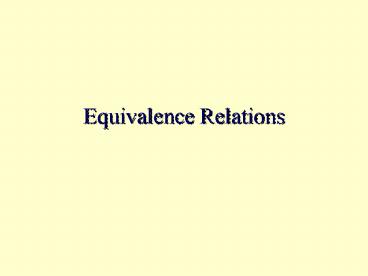Equivalence Relations - PowerPoint PPT Presentation
1 / 13
Title:
Equivalence Relations
Description:
How are the properties of an equivalence relation reflected in its graph representation? ... set S is the same thing as defining an equivalence relation over S. ... – PowerPoint PPT presentation
Number of Views:77
Avg rating:3.0/5.0
Title: Equivalence Relations
1
Equivalence Relations
2
Equivalence Relations
- A relation R on A?A is an equivalence relation
when R satisfies 3 conditions - ?x ? A, xRx (reflexive).
- ?x, y ? A, xRy ? yRx (symmetric).
- ?x, y, z ? A, (xRy ? yRz) ? xRz (transitive).
- How are the properties of an equivalence relation
reflected in its graph representation?
3
Examples?
- Let P be the set of all human beings R ? P?P.
- Is R an equivalence relation if
- aRb when a is the brother of b?
- aRb when a is in the same family as b?
- R ? N? N.
- xRy when x has the same remainder as y when they
are divided by 5?
4
Examples?
- Let R2 R?R be the set of points in the plane.
- Is E ? R2 ? R2 when
- E1 ((x1,y1),(x2,y2)) (x1,y1) (x2,y2) are
on the same horizontal line? - (E1 partitions the plane into horizontal
lines.) - E2 ((x1,y1),(x2,y2)) (x1,y1) (x2,y2) are
equidistant from the origin? - (E2 partitions the plane into concentric
circles.)
5
Partitions
- Let S be a set. A partition, ?(S), of S is a set
of nonempty subsets of S such that - ?Si ? ?(S) Si S (the parts cover S)
- ?Si?Sj ? ?(S), Si?Sj ? (the parts are disjoint)
- Example (check 2 conditions of partition)
- The same remainder when divided by 5 partitions
N into 5 parts. - E1 partitions the plane into horizontal lines.
- E2 partitions the plane into concentric circles.
6
Partitions as Equivalence Relations
- Let E ? S?S be an equivalence relation, and a ?S.
- The equivalence class determined by a is
- a b ?S aEb the set of all elements of S
equivalent to a. - Let P be the set of equivalence classes under E.
7
aEb ? a b
- I.e., any member of a can name the class.
- Assume a?b Without loss of generality, ?c
?b and c?a (draw a Venn diagram) - aEb, (given)
- bEc, (by assumption)
- aEc, (E is transitive)
- c ?a (definition of equivalence class).
- Therefore, a?b is false.
8
Equivalence classes partition S
- To prove this, we must show that
- (i) the union of all equivalence classes equals
S - (ii) if a is not equivalent to b, then a ?b
?. - (i) Since E is reflexive, ?a ?S, there is some
equivalence class that contains a a. - Therefore, ?a ? S a S.
9
Equivalence classes partition S ...
- (ii) To show For a?b, a ?b ?
- Assume not ? c ? a ?b.
- c ? a ? aEc which implies a c
- c ? b ? bEc which implies b c
- Therefore, a b, a contradiction.
- Therefore, a ?b ?.
- The set of equivalence classes partitions S.
10
A partition defines an equivalence relation
- Let ?(S) be a partition of S
- ?Si ? ?(S) Si S (the parts cover S)
- ?Si?Sj ? ?(S), Si?Sj ? (the parts are disjoint)
- Define ?E (a,b) a, b ?Si ? ?(S).
- Illustrate on blackboard.
- Claim ?E is an equivalence relation
- ?E is reflexive, symmetric, transitive.
11
?E is an equivalence relation
- (i) ?x ? S, x ?E x (reflexive)
- Since ?(S) is a partition, every x is in some
part. - Every element x of S is in the same part as
itself x ?E x. - (ii)?x, y ? S, x ?E y ? y ?E x (symmetric).
- If x is in the same part as y, then y is in the
same part as x.
12
?E is an equivalence relation ...
- (iii) ?x, y, z ? S, (x ?E y ? y ?E z) ? x ?E z
(transitive) - If x is in the same part as y and y is in the
same part as z, then x is in the same part as z. - ?E is an equivalence relation
13
Equivalence relations summary
- Partitioning a set S is the same thing as
defining an equivalence relation over S. - If E is an equivalence relation of S, the
associated partition is called the quotient set
of S relative to E and is denoted S/E.































